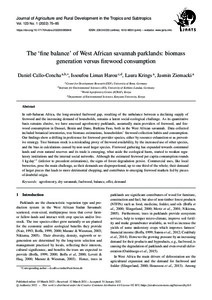The ‘fine balance’ of West African savannah parklands: biomass generation versus firewood consumption
| dc.date.accessioned | 2022-03-22T12:19:16Z | |
| dc.date.available | 2022-03-22T12:19:16Z | |
| dc.date.issued | 2022-03-15 | |
| dc.identifier | doi:10.17170/kobra-202203085848 | |
| dc.identifier.uri | http://hdl.handle.net/123456789/13713 | |
| dc.language.iso | eng | eng |
| dc.rights | Namensnennung 4.0 International | * |
| dc.rights.uri | http://creativecommons.org/licenses/by/4.0/ | * |
| dc.subject | agroforestry | eng |
| dc.subject | dry savannah | eng |
| dc.subject | fuelwood | eng |
| dc.subject | balance | eng |
| dc.subject | offer | eng |
| dc.subject | demand | eng |
| dc.subject.ddc | 300 | |
| dc.subject.ddc | 630 | |
| dc.title | The ‘fine balance’ of West African savannah parklands: biomass generation versus firewood consumption | eng |
| dc.type | Aufsatz | |
| dcterms.abstract | In sub-Saharan Africa, the long-awaited fuelwood gap, resulting of the unbalance between a declining supply of firewood and the increasing demand of households, remains a latent social-ecological challenge. As its quantitative basis remains elusive, we have assessed agroforestry parklands, assumedly main providers of firewood, and firewood consumption in Dassari, Benin and Dano, Burkina Faso, both in the West African savannah. Data collected included botanical inventories, tree biomass estimations, householders’ firewood collection habits and consumption. Our findings show a drifting in preference for firewood-provider species, either by resource exhaustion or as preventive strategy. Tree biomass stock is a misleading proxy of firewood availability, by the increased use of other species, and the bias in calculations caused by non-used larger species. Firewood gathering has expanded towards communal lands and even natural reserves and its trade is emerging, what aside the ecological harm, started to weaken regulatory institutions and the internal social networks. Although the estimated firewood per capita consumption rounds 1 kg day-1 (inferior to precedent estimations), the signs of forest degradation persist. Commercial uses, like local breweries, pose the main challenge, as their demands are disproportional, up to one third of the whole; their demand of larger pieces that leads to more detrimental chopping, and contributes to emerging firewood markets fed by pieces of doubtful origin. | eng |
| dcterms.accessRights | open access | |
| dcterms.creator | Callo-Concha, Daniel | |
| dcterms.creator | Liman Harou, Issoufou | |
| dcterms.creator | Krings, Laura | |
| dcterms.creator | Ziemacki, Jasmin | |
| dc.subject.swd | Westafrika | ger |
| dc.subject.swd | Trockensavanne | ger |
| dc.subject.swd | Agroforstwirtschaft | ger |
| dc.subject.swd | Brennholz | ger |
| dc.subject.swd | Verbrauch | ger |
| dc.subject.swd | Gleichgewicht | ger |
| dc.subject.swd | Angebot | ger |
| dc.subject.swd | Nachfrage | ger |
| dc.type.version | publishedVersion | |
| dcterms.source.identifier | eissn:2363-6033 | |
| dcterms.source.issue | No. 1 | |
| dcterms.source.journal | Journal of Agriculture and Rural Development in the Tropics and Subtropics (JARTS) | eng |
| dcterms.source.pageinfo | 75-85 | |
| dcterms.source.volume | Vol. 123 | |
| kup.iskup | false |
Dateien zu dieser Ressource
Das Dokument erscheint in:
-
Vol 123, No 1 (2022) [14]


